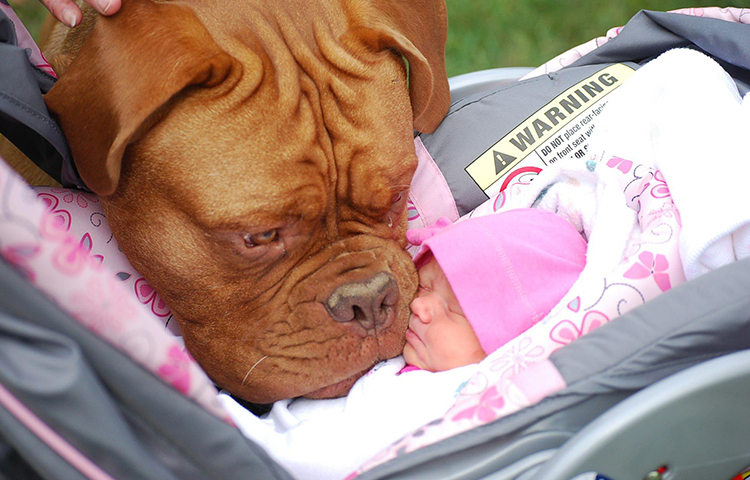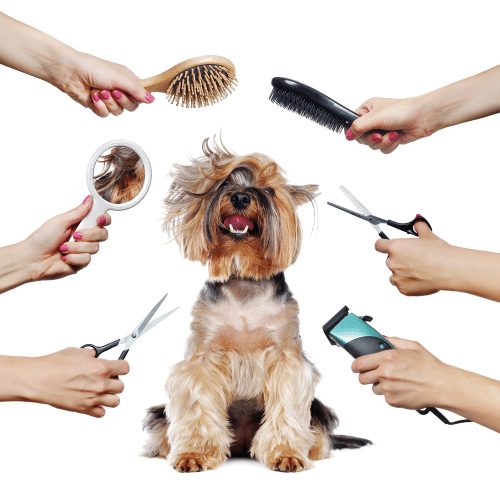By Dr. Karen Becker
For many couples, their dog or cat is the first ‘baby’ in the family. Then one day a human baby arrives on the scene, and the family dynamic changes.
 Getting your dog ready for the new baby is important. |
This is often not a happy state of affairs for the furry, four-legged kid in the household.
In order to help your dog or cat make a smooth transition from ‘only child’ to the new family, a good deal of pre-baby planning and preparation is necessary.
The best way for pet parents to help a companion animal cope with the arrival of a new baby is to plan well in advance of delivery day.
Goals should include:
- Designing a daily schedule that covers all your pet‘s needs for good nutrition, physical activity, and social interaction/playtime.
- Making gradual changes to your pet‘s daily routine before bringing the new baby home.
- Reviewing training needs, especially for dogs in the household. If your pup’s response to commands and general behavior needs some fine-tuning, the time to do it is now, before your hands are full with a new little one.
- Familiarizing your pet with all the new gear that comes with baby, especially in the nursery.
Before Baby Arrives
As I often say, preparation is priceless. And I can’t think of a more important time to plan and thoroughly prepare than when you’re an expectant parent.
You want to give both your new baby and beloved pet the time, attention and nurturing they require. And ideally you’d like to keep your sanity in the process! So you really need to design a detailed picture for yourself of how life will be once the baby arrives.
Suggestions for helping get Fido or Fluffy ready for the presence of a new baby in the house:
 Make your pet feel comfortable. |
- If your pet isn’t used to having children around, if possible, arrange to have your dog or cat spend some supervised time in the company of kids. Set up as many non-rowdy, gentle, pleasant encounters with children — preferably inside your home as well as elsewhere — as you can arrange before the baby arrives.
- Give some thought to how your daily schedule will change with a new baby, and how your pet‘s schedule will change as a result. For example, if your dog will need to be fed and walked an hour or two later each morning once the baby arrives, start working gradually toward the new schedule to give your furry companion time to adjust before the baby arrives.
- Also think about how your pet’s access to certain rooms of the house might be restricted when the baby comes home, and gradually begin enforcing those restrictions well ahead of time. Long before the due date, your pet should be comfortable when confined to her own safe spot in the house where she has access to favorite toys, bedding, water and food.
Will your pet’s playtime be moved to a different part of the day? Or will you break it up into two or three play sessions each day? Begin gradually changing the times you play with or exercise your pet well in advance of delivery.
Note any situations in which your pet‘s behavior is a problem. Does he bark too much? Does he always come when he’s called? Does he get overly excited with visitors or strangers? Does he paw or jump up on people? Take the time and put in the effort now, well ahead of baby’s arrival, to help your pet improve his manners and behavior.
For those of you who need the help of a professional animal behaviorist, I recommend you visit the American College of Veterinary Behaviorists and/or the American Behavior Society.
Decide ahead of time whether your pet will be allowed in the nursery. If it will be off limits, train your pet with calm consistency to stay out. A barricade like a baby gate may be necessary, at least initially. It will be much easier to keep your dog outside the room than your cat, so practice in advance for how you’ll convince kitty to steer clear of the nursery.
If your pet will be allowed in the baby’s room, introduce her to the new furniture, baby gear and belongings and all the novel smells. Keep things calm and pleasant whenever you’re in the nursery with your pet. Let your dog or cat investigate thoroughly. Give praise and rewards for calm behavior whenever she’s in the baby’s domain.
If your dog or cat is especially apprehensive or fearful of new experiences – sights, sounds, odors and other strange stimuli — you might want to consider practicing baby care in front of your pet with a doll. Hold the doll, change a diaper, simulate feeding, etc. You can even play a recording of a baby crying to get your pet used to the noises infants make. Gauge your pet’s reaction to these childcare activities and institute positive reinforcement behavior training and socialization as necessary.
If your pet is particularly anxious, consider placing either a DAP (for dogs) or Feliway (for cats) diffuser in your home 2 weeks before the baby’s due date. You can also consider an all-natural stress-relief remedy like the OptiBalancePet formulas.
When Baby Comes Home
If possible, while your new little bundle is still in the hospital, have someone bring an item of clothing the baby has worn home for your pet to smell. Arrange to have a third party hold your baby as you all enter the house for the first time. This leaves you free to greet your pet. Once things have settled down, have the person holding the baby take a comfortable seat and then introduce the pet to the baby. If there’s more than one pet, introduce each one individually. Dogs are generally more eager than cats to greet new visitors. Be prepared to restrain your dog if necessary using a leash or harness. Allow a cat to investigate the new arrival on his own schedule – don’t force anypet to interact with the baby.
Immediately handle any signs of aggression or other unacceptable behavior on the part of your pet toward the baby. Immediately remove the pet from the room and isolate her. Only you can determine if you need outside assistance, but don’t be afraid to reach out to an animal behaviorist if you’re concerned about your pet’s interaction with your child.
If your pet isn’t being aggressive but is still posing a threat of some kind, for example, crawling or lying on the baby, redirect the behavior to something desirable. Give praise and rewards for successful redirection.
Needless to say, constant supervision of all interaction between your pet and your baby is necessary.
Make every effort not to exclude your pet by ignoring him, disciplining him out of your fear rather than his inappropriate behavior, confining him from the rest of the family, or waiting until the baby is sleeping to interact with him. A pet that has been in the middle of things until the arrival of a baby will naturally feel anxious and even depressed when he’s pushed aside. What you don’t want to do is teach your dog or cat the presence of baby is a bad thing.
 Balance time between your new baby and your pet. |
Make a point to pay attention to your pet when the baby is awake and right there with you. You can simply talk to your pet as you’re tending to the baby, or if there are other adults present, someone can pet or play with the dog or cat. Scheduling walks together with your dog and the baby is also a good idea. Insure you don’t save all interactions with your pet for when the baby is sleeping.
Get your pet used to being handled a bit awkwardly. Your baby will grow into a toddler who will naturally want to touch, pat, stroke, hug and tug on your dog or cat. Even though you’ll be there to supervise every interaction between your child and your pet, it’s still a good idea to help your dog or cat learn what to expect from a little person as opposed to an adult.
Most pets become aggressive with humans out of fear. Once baby is crawling and then walking, your dog or cat has another new situation to deal with. Make sure your pet is always able to move away from your child. Feelings of being cornered or trapped can make an animal aggressive.
Keep in mind most scratches and especially dog bites involving children happen when a pet is startled out of sleep, or is eating. I recommend that until your child is old enough to understand cautious, respectful behavior toward animals, you keep the two separate when your pet is either eating or resting. And of course you’ll want to supervise every single interaction between them, regardless of the circumstances.

Source:
Robert Mueller, BSc, Pharm. is a registered pharmacist, author of “Living Enzymes: The World’s Best Kept Pet Food Secret”.











